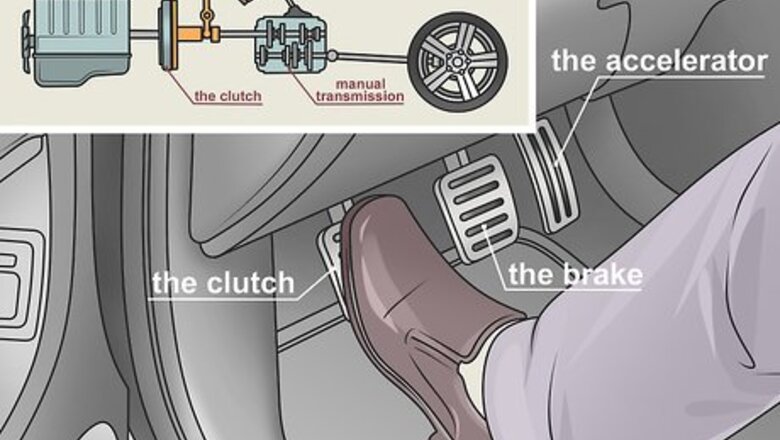
views
Using the Clutch

Keep your left foot resting on the clutch at all times. The clutch is the pedal all the way on the left and is what allows you to transition between gears. Knowing how to use the clutch when you change gears is key to driving smoothly when you’re operating a manual transmission. To make sure you can engage the clutch whenever you need to, keep your left foot on it without applying any pressure. The pedal on the left is the clutch, the pedal in the center is the brake, and the pedal on the right is the accelerator or gas pedal.
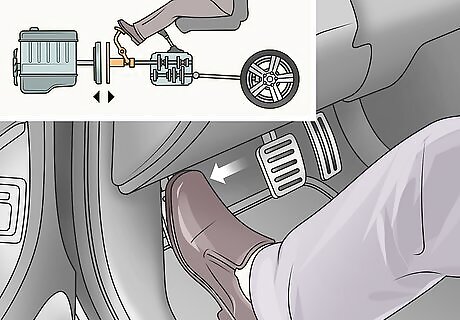
Press the clutch to the floor to put the engine in neutral. The neutral gear refers to the stage where no gear is engaged. The vehicle’s engine must be in neutral in order for you to transition between the gears. Push the clutch pedal to the floor in a smooth and controlled fashion to put the engine in the neutral gear. Don’t stomp or slam on the clutch or you could damage the pedal. Be careful not to press the clutch to the floor after you try to move the gear shift or you could stall the engine and cause the vehicle to jolt and shake.
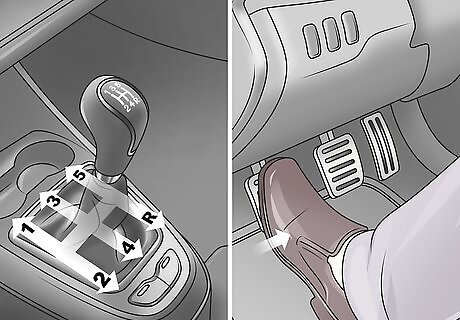
Release the clutch slowly when you use the gear shift to transition smoothly. The gear shift is the stick in the center console of the vehicle that allows you to choose the gear you want to transition to. When it comes time for you to change gears, press the clutch to the floor to put the engine in the neutral gear, and slowly release the clutch as you switch the gear shift into another gear. Practice shifting gears in an empty parking lot or a quiet road so you can get used to releasing the clutch and transitioning smoothly.

Let the clutch all the way up once the gear is engaged. After you’ve moved the gear shift to the gear you wanted to transition to, fully disengage the clutch by releasing your left foot. Keep your left foot gently pressed against the clutch so you can engage it when you need to change gears again. Don’t rest the full weight of your foot on the clutch or you could accidentally engage it if you suddenly stop and the engine will be put in the neutral gear.
Shifting Gears
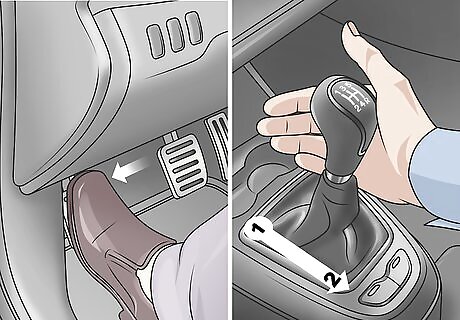
Press the clutch to the floor when you’re ready to change gears. When it comes time to shift gears, use your left foot to engage the clutch by pushing the pedal to the floor. Push the pedal down smoothly rather than stomping it. This will put the engine in neutral so you can transition between gears. Do not engage the clutch until you’re ready to change gears or you could cause the car to lurch and make for an uncomfortable ride.
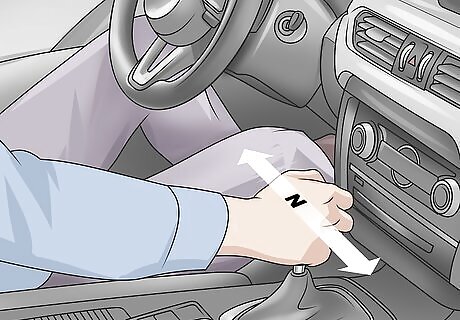
Move the gear shift into the neutral position. The gear shift in the middle console has a center position that allows you to put the engine in the neutral gear. You’ll know you’re in the neutral position when you can wiggle the stick freely from side to side. The clutch must be engaged in order for you to move the gear shift into neutral.
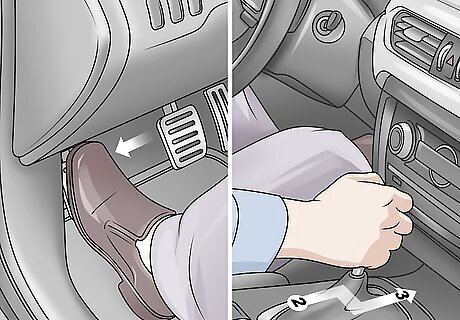
Shift into the next gear when the RPM reaches 2500. RPM refers to revolutions per minute and it’s a measurement of how fast your engine is operating. On your dash is a gauge that shows the RPMs. When you’re driving and the RPMs reach the 2500 range, it’s time for you to shift into the next higher gear. Shifting when it’s the right time will make the vehicle drive smoother. Shifting at the correct time will also keep your engine running well and will make it last longer.
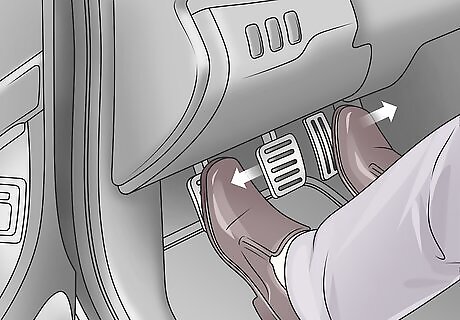
Release the clutch slowly and gently press on the accelerator. After you’ve moved the gear shift into the gear that you want, slowly release your left foot from the clutch as you gently apply pressure to the accelerator pedal. With practice, you will feel the engine change gears smoothly. Every engine is a little bit different. Practice changing gears to make the transition smoother.
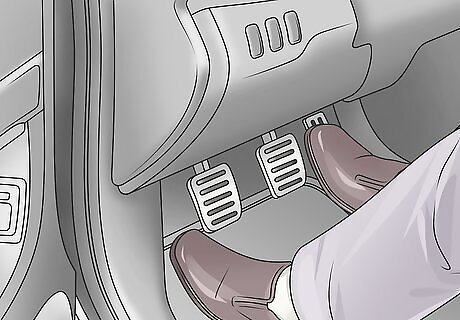
Remove any pressure from the clutch once the gear is engaged. Once the engine has transitioned to another gear and the accelerator is pressed, you can let up on the clutch. This will fully engage the engine in the gear you’ve shifted to. Keep your foot near the clutch in case you need to change gears again. Gain clarity on gear changes. "I was totally confused and clueless about how to properly change gears in a stick-shift car. This article was so clear and simple; it really opened my eyes to what I needed to do. Now, I actually understand the steps to make smooth gear changes thanks to the straightforward explanations any beginner could follow. It was super helpful for this manual transmission newbie!" - Clive F. Master balancing pedal pressure. "The tips in this article were awesome for teaching me how to coordinate the clutch and gas pedals. I learned how to smoothly shift down through the gears while balancing how much I press on each pedal. Before reading this, I was stalling the engine all the time by letting off the clutch too fast. But with the great advice on pedal use, I can now shift up and down with no problem." - Trevor O. Correct poor shifting habits. "This guide was excellent at pointing out what bad habits I'd developed trying to shift a manual transmission car. I didn't realize I was letting off the clutch too suddenly, which explained why I kept stalling. The step-by-step instructions let me improve my sloppy shifting and learn to transition smoothly between gears. So helpful!" - Yogesh S. Gain downshifting knowledge. "I used to struggle with downshifting in my manual car, but this article explained it perfectly. Now I know I should shift to lower gears while the engine is still revving high. That advice helped me become a much smoother driver. I'm so thankful to understand proper downshifting techniques now!" - Ntsikelelo P. Have a story our readers should hear? Share it with 1 billion+ annual wikiHow users. Tell us your story here.
Pressing the Accelerator

Avoid removing your foot from the accelerator suddenly, if possible. The accelerator is what controls the engine’s RPMs and the speed of the vehicle. If you suddenly release all of the pressure from the pedal, the car will jolt forward and could cause the passengers to lurch forward in their seats. If you need to suddenly brake, you must release all of the pressure from the accelerator pedal to press the brake with your right foot.
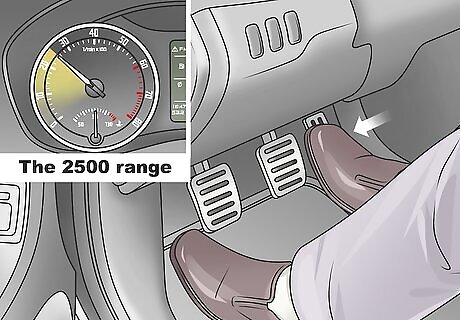
Press on the accelerator gently to smoothly increase the vehicle’s speed. When the engine is in gear, to increase your speed smoothly, continue to apply pressure with your right foot to the accelerator pedal. Continue to press until the RPMs get to the 2500 range on your dashboard display. Don’t slam on the accelerator or the vehicle will launch forward and feel uncomfortable to anyone inside of it.
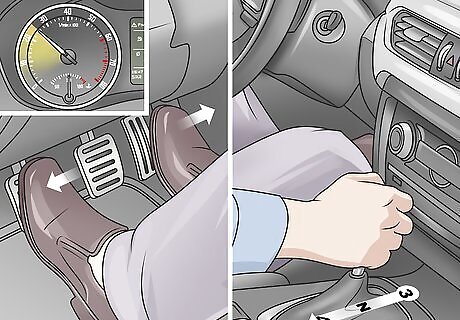
Release the accelerator gently when you want to change gears. Once the RPMs have reached the 2500 range, it’s time to change gears. Slowly pull your right foot off of the accelerator so the engine doesn’t continue to ramp up RPMs as you place it in neutral gear to transition. If the RPMs are too high when you change gears, the engine will make a rattling sound and the vehicle will shake. Avoid releasing all of the pressure from the accelerator at once or the car will jolt forward and will feel unpleasant to the passengers.
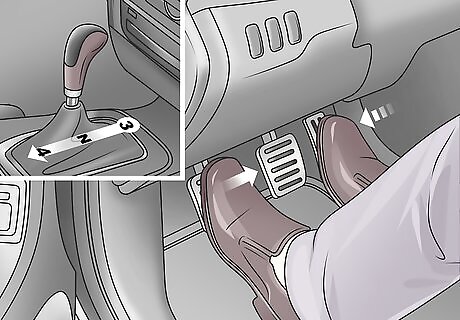
Apply a small amount of pressure to the accelerator as you release the clutch. After you shift the gear stick into a different gear, gently apply pressure with your right foot while you release pressure with your left foot on the clutch. Finding the balance as the gear takes hold is important to make the vehicle drive smoothly.
Operating Smoothly While Driving

Slow down ahead of speed bumps and turns. To keep your vehicle moving smoothly, be sure to slow down well ahead of any speed bumps, turns, or stoplights that you approach. Engage the clutch to put the gear shift into the neutral position if you need to slow down to the point where you need to put the engine in a lower gear. Pay attention to road signs that will tell you when a speed bump or turn is coming up.
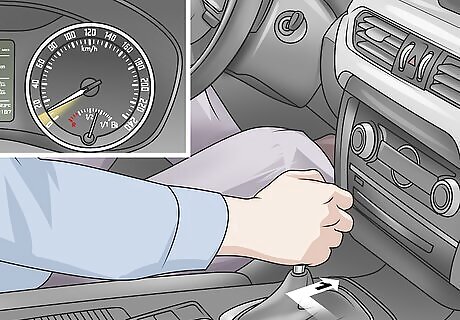
Keep the vehicle in 1st gear in slow-moving traffic. If you’re in traffic that’s traveling at speeds up to about 10 miles (16 km) per hour, keep the engine in first gear so you can move forward steadily. The vehicle won’t move forward if it’s in the neutral gear. Shift the vehicle into second gear when the traffic gets up to about 15 miles (24 km) per hour. Be sure to keep at least 1 car length in front of you in case you need to stop suddenly.
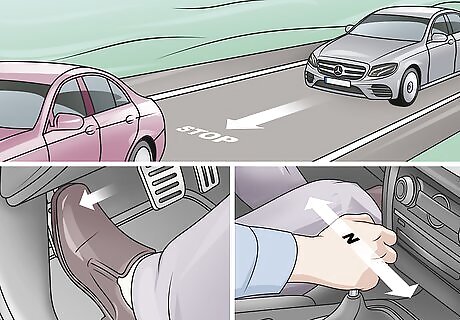
Put the gear shift in the neutral position when traffic stops or slows to a crawl. If you’re moving too slow in 1st gear, the engine could stall. Engage the clutch, shift the gear shift into neutral, and release the clutch to keep the engine in neutral. Let the vehicle roll and use your breaks to slow it down or stop if you need to. Don’t keep the clutch held partway down. That’s called “riding the clutch” and can damage and wear out your clutch.
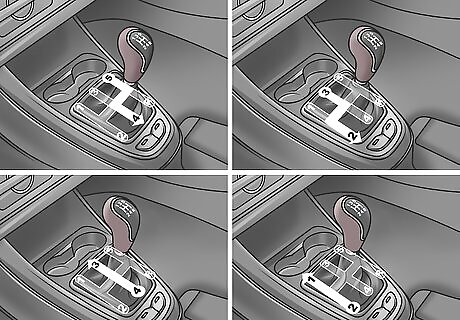
Downshift while using the breaks to slow down from a higher gear. Don’t put the engine into the neutral gear then coast while using your breaks to slow down or you could cause the vehicle to jerk or the gears to grind. Instead, shift back down through the successive gears until you’re in the gear that’s best suited to maintain the speed that traffic is moving in. Don’t skip gears. For instance, don’t shift from 4th gear straight to 2nd or it can cause the gears to grind and the vehicle to shake uncomfortably.
















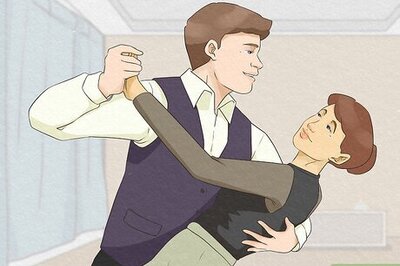

Comments
0 comment